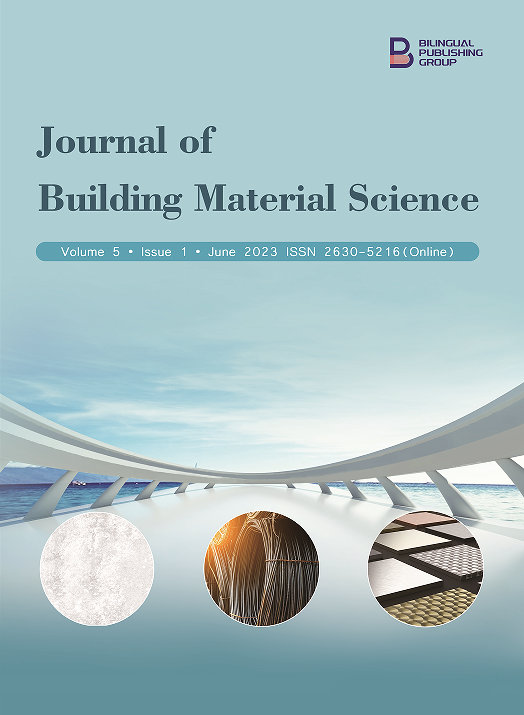
Evaluation of the Relationship between Bacteria Concentration and the Strength and Durability of Self-compacting Concrete Incorporating Sporosarcina pasteurii
DOI:
https://doi.org/10.30564/jbms.v5i1.5596Abstract
This research was carried out to evaluate the relationship between the incorporation of calcite precipitation bacteria, sporosarcina pasteurii using calcium lactate as nutrient source and the properties of calcined clay and limestone powder blended self-compacting concrete. Ten mixes were designed and designated S0 to S9 with S0 the control (without bacteria and nutrient) and S1 to S9 at varying bacteria and calcium lactate concentrations and the effect of the bacteria cell density and calcium lactate concentration on the compressive strength, sorptivity and tensile strength with age evaluated using experimental program and statistical packages (ANOVA and post hoc tests). The result of both the experimental program and statistical evaluation shows that the incorporation of sporosarcina pasteurii and calcium lactate as nutrient had a positive impact on the properties of the ternary blended self-compacting concrete.
Keywords:
Sporosarcina pasteurii; Calcium lactate; Ternary self-compacting concrete; Statistical evaluation; Strength and durabilityReferences
[1] Hasanzadeh, B., Sun, Z., 2019. Impacts of diatomaceous earth on the properties of cement pastes. Journal of Building Materials and Structures. 5(2), 197–211. DOI: https://doi.org/10.5281/zenodo.2538094
[2] Taku, J.K., Amartey, Y.D., Ejeh, S.P., et al., 2021. Durability evaluation of calcined clay and limestone powder blended ternary self-compacting concrete. Journal of Engineering Sciences. 8(1), C1–C10.
[3] Lara, C.R., Diaz, A.A., Scrivener, K., et al., 2011. Study of the addition of calcined clays in the durability of concrete. Revista Ingenieria de Construccion. 28(1), 25–40.
[4] Ma, L., Pang, A.P., Luv, Y., et al., 2020. Beneficial factors for bio-mineralization by ureolytic bacteria Sporosarcina pasteurii. Microbial Cell Factories. 19(1), 1–12. DOI: https://doi.org/10.1186/s12934-020-1281-z
[5] Karihaloo, B.L., Ghanbari, A., 2012. Mix proportioning of self-compacting high- and ultra-high-performance concretes with and without steel fibres. Magazine of Concrete Research. 64(12), 1089–1100. DOI: https://doi.org/10.1680/macr.11.00190
[6] Deeb, R., Karihaloo, B.L., 2013. Mix proportioning of self-compacting normal and high strength concretes. Magazine of Concrete Research. 65(9), 546–556.
[7] Ghanbari, A., Karihaloo, B.L., 2009. Prediction of the plastic viscosity of self-compacting steel fibre reinforced concrete. Cement and Concrete Research. 39(12), 1209–1216.
[8] BS EN 12390-3, 2009. Testing Hardened Concrete. Compressive Strength of Test Specimens. BSI: London.
[9] BS EN 12390-6, 2009. Testing Hardened Concrete. Tensile Splitting Strength of Test Specimens. BSI: London.
[10] ASTM C1585-13, 2013. Standard Test Method for Measurement of Rate of Absorption of Water by Hydraulic-Cement Concretes. ASTM International: West Conshohocken, PA.
[11] Vaezi, M., Zareei, S.A., Jahadi, M., 2020. Recycled microbial mortar: Effect of bacterial concentration and calcium lactate content. Construction and Building Materials. 234, 1–12.
[12] Irvan, J.M., Teddy, T., 2017. An overview of bacteria concrete on concrete durability in aggressive environment. Pertanika Journal of Science and Technology. 25(5), 259–264.
[13] Mondel, S., Ghosh, A.D., 2018. Investigation on the optimal bacteria concentration for compressive strength enhancement of microbial concrete. Construction and Building Materials. 142, 202–214.
[14] Chahal, N., Siddique, R., Rajor, A., 2012. Influence of bacteria on the compressive strength, water absorption and rapid chloride permeability of concrete incorporating silica fume. Construction and Building Materials. 37, 645–651. DOI: https://doi.org/10.1016/j.conbuildmat.2012.07.029
[15] Pereira de Oliveira, L.A., Gomes, J.P., Pereira, C.N.A., 2006. Study of sorptivity of self-compacting concrete with mineral additives. Journal of Civil Engineering and Management. 12(3), 215–220.
[16] Dhandapani, Y., Vignish, K., Raja, T., et al., 2018. Development of the Microstructure in LC3 Systems and its effect on concrete properties. In: Martirena, F., Favier, A., Scrivener, K. (editors). Calcined Clays for Sustainable Concrete. RILEM Bookseries, vol 16. Springer: Dordrecht. pp. 131–140. DOI: https://doi.org/10.1007/978-94-024-1207-9_21
[17] Barkat, A., Kenai, S., Menadi, B., et al., 2019. Effects of local metakaolin addition on rheological and mechanical performance of self-compacting limestone cement concrete. Journal of Adhesion Science and Technology. 33(9), 963–985. DOI: https://doi.org/10.1080/01694243.2019.1571737
[18] Karatas, M., Benli, A., Arslan, F., 2020. The effects of kaolin and calcined kaolin on the durability and mechanical properties of self compacting concrete mortars subjected to high temperatures. Construction and Building Materials. 265, 1–12. DOI: https://doi.org/10.1016/j.conbuildmat.2020.120300
[19] Sravanthi, M., Rao, S.V., Krishnaveni, K., et al., 2022. Studies on compressive strength and microstructural analysis of selfcompacting mortars with bacteria. Communications. 24(4), D183–D200. DOI: https://doi.org/10.26552/com.C.2022.4.D183-D200
[20] Weber, M., Thiele, C., 2018. Correlation between compressive and tensile strength of old concretes: Applicability of the relationship described in EN 1992-1-1. Structural Concrete. 20(1), 483–492. DOI: https://doi.org/10.1002/suco.201700244
Downloads
How to Cite
Issue
Article Type
License
Copyright © 2023 Engr K Taku;Amartey, B. H. S.; Agber, T.

This is an open access article under the Creative Commons Attribution-NonCommercial 4.0 International (CC BY-NC 4.0) License.







 Engr K Taku
Engr K Taku





